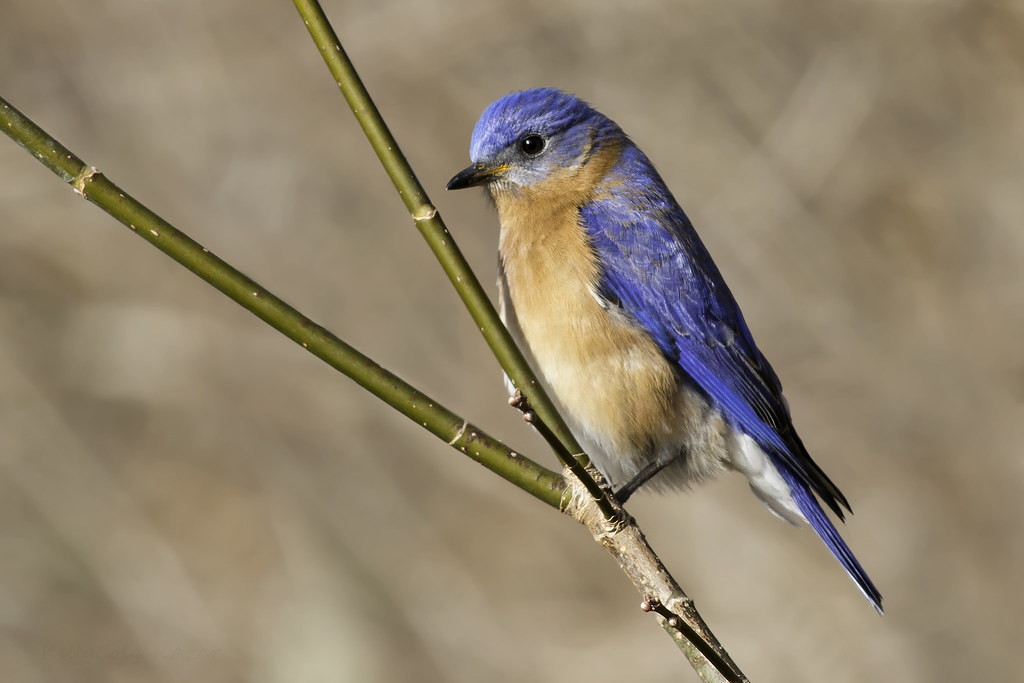
Bluebirds are some of North America’s most beloved songbirds. If you live in South Carolina, you may be familiar with seeing bluebirds out in the countryside or perched up on a telephone wire. Fortunately, these birds can easily be spotted all over the state, so even if you have never seen one, there’s still hope. For any South Carolina residents who are interested in bluebirds, you’ve come to the right place. This is your ultimate resource for Bluebirds in South Carolina!
Contents
- What Species of Bluebirds Live in South Carolina?
- Where to See Bluebirds in South Carolina
- Similar Birds
- How to Attract Bluebirds
- Feeding Bluebirds
- What Nest Box Should I Use for Bluebirds in South Carolina?
- Get Involved In Bluebird Conservation
- South Carolina Bluebird Conservation Organizations
- How to Report Your Bluebird Fledglings in South Carolina
- South Carolina Bluebird FAQs

Photo by Kelly Colgan Azar is licensed under CC BY-ND 2.0
What Species of Bluebirds Live in South Carolina?
There are three species of bluebirds that live in the United States, but the Eastern Bluebird is the only species found in South Carolina. Eastern Bluebirds find their home in the Carolinas and in other states, primarily east of the Rocky Mountains. They are frequently seen in open areas, like fields and backyards, where they have plenty of space to hunt for insects.
Even though these birds once saw a population decline in the US, thanks to conservation efforts, Eastern Bluebirds are now common throughout the Palmetto State.
A similar species, the Western Bluebird, rarely flies as far east as South Carolina. However, due to their expansive migratory patterns, sometimes they show up in eastern states just to stop by. On this radio show (click here), there is a recording of a Western Bluebird that decided to show up in South Carolina. It’s infrequent but it does happen!
Now, let’s get back top Eastern Bluebirds – the stars of South Carolina.
Eastern Bluebird Fast Facts
| Latin Name | Sialia sialis |
| Habitat | Grasslands, open fields, countryside |
| Diet | Mostly insects – typically crickets, caterpillars, spiders, beetles |
| Nest Type | Secondary-cavity nesters – old woodpecker holes, dead trees, nest boxes |
| Nest Description | Dry grasses, animal hair, pine needles |
| Egg Description | 3-5 pale blue (or sometimes white) eggs |
| Conservation Status | Low Concern |

Photo by 611catbirds, too is licensed under CC BY 2.0
Where to See Bluebirds in South Carolina
As a general rule, you can find bluebirds in South Carolina in many open places out in the country. They typically live in places with scattered trees, fence rows, open fields, and where old woodpecker holes or nest boxes are available for nesting.
Common places to find bluebirds in South Carolina:
- Open fields
- Backyards
- Golf courses
- Fence posts
- Telephone wires
- Cemeteries
Similar Birds to Bluebirds in South Carolina
Blue Jays and Indigo Buntings are blue-colored birds that are often incorrectly called “bluebirds.” However, they are different species entirely. Blue Jays are much larger blue-colored birds found throughout much of the eastern and central United States. Indigo Buntings are smaller, but rarer, blue-colored birds that people also confuse with Eastern Bluebirds.
Species: Blue Jay

Photo by U. S. Fish and Wildlife Service – Northeast Region is marked with CC PDM 1.0
Species: Indigo Bunting

Photo by Kelly Colgan Azar is licensed under CC BY-ND 2.0
Learn more about how to differentiate between Eastern Bluebirds and Indigo Buntings in this article that I wrote here.

Photo by ibm4381 is licensed under CC BY 2.0
How to Attract Bluebirds in South Carolina
The best way to attract bluebirds in South Carolina is to put up a nest box in an open area. Since bluebirds are secondary-cavity nesters, they make use of old woodpecker holes, natural tree cavities, and nest boxes to build their nest. They cannot build nests in trees like robins, cardinals, or many other birds.
If you have a medium to large sized backyard in the country, consider putting up a bluebird nest box. If you set up a bluebird house in the middle of February, you could have a nesting pair of bluebirds by early spring!
Learn everything you need to know about attracting bluebirds in the article that I wrote here: How to Attract Bluebirds.

Feeding Bluebirds
If you have already spotted bluebirds in your area, you can also train them to come to a bird feeder. However, they won’t eat the same seeds that you might put out for other birds. At a bird feeder, bluebirds enjoy live mealworms, especially during the summer when insects make up the majority of their diet. During the winter, when insects become scarce, you can attract bluebirds to your feeder with sunflower seed hearts, berries, pieces of fruit, chopped peanuts, and peanut butter. For winter bluebird feeding tips, check out this article I wrote here.
What Nest Box Should I Use for Bluebirds in South Carolina?

Photo by Dolan Trout is licensed under CC BY 2.0
The two best nest boxes to use for bluebirds in South Carolina are the following:
- A wooden nest box with a 1 1/2 inch round entrance hole (see my favorite one here)
- The Gilbertson-style PVC pipe nest box with a 1 1/2 inch round entrance hole (see my pick here)
Each of these styles of nest boxes work well for Eastern Bluebirds and they have proven successful at attracting bluebirds in South Carolina.
If you already have a bluebird house at home, make sure that it has a round entrance hole that is exactly 1 1/2 inches in diameter. If the hole is too small, bluebirds won’t be able to enter the nest box. But, if the entrance hole is too large, it may allow European Starlings to enter, which are an invasive species that compete heavily with bluebirds for nesting sites. So, make sure your bluebird house is built to the proper size. Learn more about entrance hole size in this article here.
Get Involved With Bluebirds in South Carolina
If you want to get involved with bluebird conservation in South Carolina, the best thing you can do is to become an active bluebird landlord. What is a bluebird landlord? A bluebird landlord is someone who attracts and cares for bluebirds by providing a safe place for them to nest.
You can do a lot for bluebirds just by providing a safe place for them to nest in your backyard. I wrote an article called 10 Steps to Become a Bluebird Landlord. Read that article and get started attracting bluebirds to your backyard today!
If you want to get even more involved in bluebird conservation in South Carolina, consider joining an official conservation organization.
Bluebird Conservation Organizations in South Carolina
The South Carolina Bluebird Society is the state’s most active bluebird conservation organization. In their own words, they work to “provide informative, factual, accurate, and educational information about our amazing Bluebirds and other cavity-dwelling birds that we also protect” (source).
You can find out more information about this organization on their website here. Consider becoming a member or making a donation to support bluebirds and the organization.
How to Report Your Bluebird Fledglings
The best way to officially report your bluebird fledglings in South Carolina is to fill out the form on the South Carolina Bluebird Society’s website. You can read all about how to report your fledglings by clicking here.
You can also report your fledglings and nest activity to NestWatch.org, which is an affiliate of the Cornell Lab of Ornithology. Click this link to get started reporting your bluebird fledglings there.
Frequently Asked Questions
Do bluebirds stay in South Carolina in the winter?
As a general rule, bluebirds stay in South Carolina all winter long. Eastern Bluebirds that live in the northern part of the US, such as northern Michigan, typically fly to the southeastern states for the winter. However, it is common for Eastern Bluebirds to stay in South Carolina all year long due to the relatively mild temperatures and year-round food availability.
Conclusion
Eastern Bluebirds are one of America’s most beloved birds. With their strikingly blue color, their gentle song, and their preference for the quiet countryside, bluebirds often evoke a sense of peace and nostalgia for South Carolina residents.
If you are interested in attracting Eastern Bluebirds to your own backyard, learn how you can do that by reading my article called How to Attract Bluebirds.
Which species of bluebird lives in your state? Click here to find out what species of bluebirds to look for in all fifty US states.


